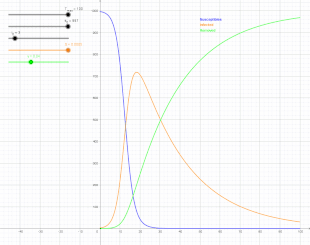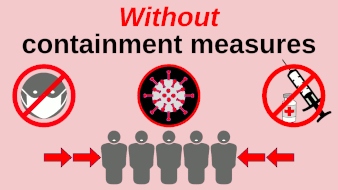
Back تسطيح المنحنى Arabic Marataakan langkuk BJN Aplanar la curva Spanish Hazkundearen kurba apaldu Basque Aplatir la courbe French שיטוח העקומה HE Meratakan kurva ID Mendatarkan keluk Malay Achatar a curva Portuguese Flatten the curve SIMPLE

Flattening the curve is a public health strategy to slow down the spread of an epidemic, used against the SARS-CoV-2 virus during the early stages of the COVID-19 pandemic. The curve being flattened is the epidemic curve, a visual representation of the number of infected people needing health care over time. During an epidemic, a health care system can break down when the number of people infected exceeds the capability of the health care system's ability to take care of them. Flattening the curve means slowing the spread of the epidemic so that the peak number of people requiring care at a time is reduced, and the health care system does not exceed its capacity. Flattening the curve relies on mitigation techniques such as hand washing, use of face masks and social distancing.
A complementary measure is to increase health care capacity, to "raise the line".[4] As described in an article in The Nation, "preventing a health care system from being overwhelmed requires a society to do two things: 'flatten the curve'—that is, slow the rate of infection so there aren't too many cases that need hospitalization at one time—and 'raise the line'—that is, boost the hospital system's capacity to treat large numbers of patients."[5] During 2020, in the early stages of the COVID-19 pandemic, two key measures were to increase the numbers of available ICU beds and ventilators, which were in systemic shortage.[2][needs update]
Experts differentiate between "zero-COVID", which is an elimination strategy taken by China, and "flattening the curve", a mitigation strategy that attempts to lessen the effects of the virus on society as much as possible, but still tolerates low levels of transmission within the community.[6][7] These two initial strategies can be pursued sequentially or simultaneously during the acquired immunity phase through natural and vaccine-induced immunity.[8]
- ^ Wiles, Siouxsie (9 March 2020). "The three phases of Covid-19—and how we can make it manageable". The Spinoff. Morningside, Auckland, New Zealand. Archived from the original on 27 March 2020. Retrieved 9 March 2020.
- ^ a b Cite error: The named reference
:3was invoked but never defined (see the help page). - ^ Maier, Benjamin F.; Brockmann, Dirk (15 May 2020). "Effective containment explains subexponential growth in recent confirmed COVID-19 cases in China". Science. 368 (6492): 742–746. Bibcode:2020Sci...368..742M. doi:10.1126/science.abb4557. PMC 7164388. PMID 32269067. ("...initial exponential growth expected for an unconstrained outbreak.")
- ^ Beating Coronavirus: Flattening the Curve, Raising the Line (YouTube video). Retrieved 12 April 2020.
- ^ Gelardi, Chris (9 April 2020). "Colonialism Made Puerto Rico Vulnerable to Coronavirus Catastrophe". The Nation. ISSN 0027-8378. Archived from the original on 12 April 2020. Retrieved 12 April 2020.
- ^ Oliu-Barton, Miquel; Pradelski, Bary S R; Aghion, Philippe; Artus, Patrick; Kickbusch, Ilona; Lazarus, Jeffrey V; Sridhar, Devi; Vanderslott, Samantha (28 April 2021). "SARS-CoV-2 elimination, not mitigation, creates best outcomes for health, the economy, and civil liberties". The Lancet. 397 (10291): 2234–2236. doi:10.1016/S0140-6736(21)00978-8. PMC 8081398. PMID 33932328.
- ^ Li, Zhongjie; Chen, Qiulan; Feng, Luzhao; Rodewald, Lance; Xia, Yinyin; Yu, Hailiang; Zhang, Ruochen; An, Zhijie; Yin, Wenwu; Chen, Wei; Qin, Ying; Peng, Zhibin; Zhang, Ting; Ni, Daxin; Cui, Jinzhao; Wang, Qing; Yang, Xiaokun; Zhang, Muli; Ren, Xiang; Wu, Dan; Sun, Xiaojin; Li, Yuanqiu; Zhou, Lei; Qi, Xiaopeng; Song, Tie; Gao, George F; Feng, Zijian (4 June 2020). "Active case finding with case management: the key to tackling the COVID-19 pandemic". The Lancet. 396 (10243): 63–70. doi:10.1016/S0140-6736(20)31278-2. PMC 7272157. PMID 32505220.
- ^ Bhopal, Raj S (9 September 2020). "To achieve "zero covid" we need to include the controlled, careful acquisition of population (herd) immunity". BMJ. 370: m3487. doi:10.1136/bmj.m3487. eISSN 1756-1833. hdl:20.500.11820/59628557-672e-47bb-b490-9c9965179a27. PMID 32907816. S2CID 221538577.


